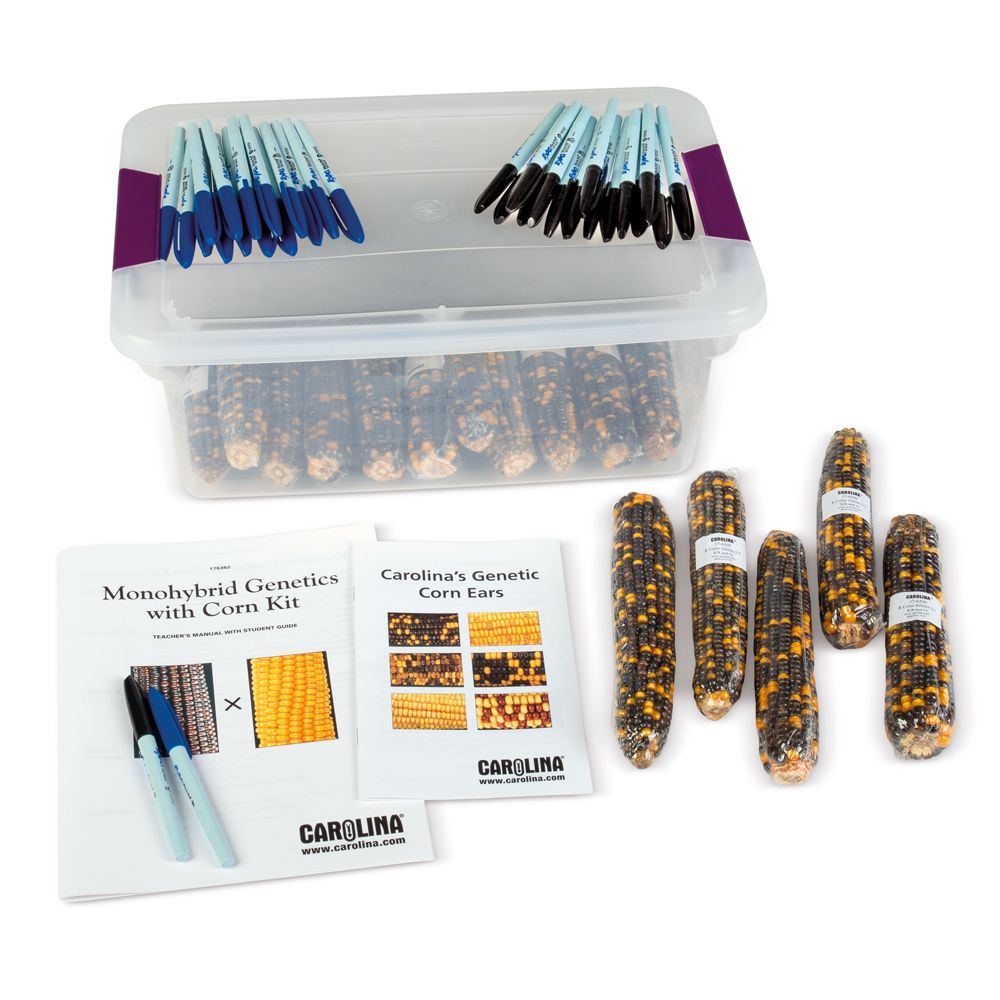Corn as an Introduction to Mendelian Genetics
A Carolina Essentials™ Activity

Total Time: 45-60 mins
Prep: 15 mins | Activity: 30-45 mins

Life Science
- Total Time: 45-60 minutes [ Prep: 15 mins | Activity: 30-45 mins ]
- Subject: Life Science
- Grade: High School
Overview
Corn is the ideal organism for introducing students to Mendelian genetics. Corn kernels express numerous phenotypes that are easy to recognize. The phenotypes typically used involve the color or shape of the kernel.
Carolina maintains parental stocks of yellow and purple corn colors. Purple corn is the result of a dominant allele, and yellow corn is the result of the recessive allele of the same gene. Each kernel on an ear of genetic corn represents an offspring. This means students can immediately begin collecting data without performing genetic crosses themselves. Since there are generally 200 or more kernels per ear, it takes only a few ears to produce reliable data.
Students will gather data on two monohybrid crosses: purple crossed with yellow, and the resulting F1 crossed with F1 corn. The F1 of the purple: yellow cross expresses the purple phenotype and looks like the purple parent stock, but it carries the recessive allele for yellow. When the F1 kernels are planted and allowed to freely cross-pollinate, the recessive phenotype reappears in the resulting F2 ears in a 3:1 ratio. The phenotype breakdown for the purple: yellow cross consists of 3 purple (dominant) and 1 yellow (recessive).

Phenomenon
Hold up the parental ears of corn (purple and yellow). Ask students this question: What do you need to ask about these ears of corn to know what kind of offspring they could produce? Give students 2 to 3 minutes to generate questions individually and then share with the class. Guide students to questions that can be answered using genetics.
Essential Question
Based on Mendelian genetics, what questions need to be asked and then answered to predict the phenotypic traits of offspring?
Activity Objectives
- Ask, then answer the questions necessary to determine the genetic relationships between parent, F1, and F2 generations of corn.
- Test the answers to the questions above using Punnett squares.
Next Generation Science Standards* (NGSS)
PE MS-PS1-2. Analyze and interpret data on the properties of substances before and after the substances interact to determine if a chemical reaction has occurred.
Science & Engineering Practices
Asking Questions and Defining Problems
- Ask questions that arise from examining models or a theory to clarify relationships.
Disciplinary Core Ideas
LS3.A: Inheritance of Traits
- Each chromosome consists of a single very long DNA molecule, and each gene on the chromosome is a particular segment of that DNA. The instructions for forming species’ characteristics are carried in DNA. All cells in an organism have the same genetic content, but the genes used (expressed) by the cell may be regulated in different ways.
Crosscutting Concepts
Cause and Effect
- Empirical evidence is required to differentiate between cause and correlation and make claims about specific causes and effects.
Materials
Note: Carolina’s genetic corn is pollinated, grown, and harvested under controlled conditions. The use of other varieties of corn may or may not yield the correct phenotypicratios.
Safety & Disposal
Corn ears have been treated with a sealant, but make certain to identify students with corn allergies to determine whether handling the corn will cause an allergic reaction.
Procedures
Examine each F2 ear of corn to ensure that kernels are not missing. If an ear has a large number of missing kernels, then the ratio of phenotypes could be incorrect. Collect corn ears and store them in a cool dry place for extended use.
Student Procedures
- Observe the first generation, F1, of offspring from the cross of a purple kernel parent and a yellow kernel parent. Record the observations in the data table.
- Observe the F2 generation of corn. Count the number of each different phenotype (color) of kernel.
- Add the data to the class data table.
- Record the class data.
Teacher Preparation and Tips
- Review the terms recessive, dominant, homozygous, and heterozygous.
- Create a class data table for all groups to enter their data. You may wish to complete the calculations as a class if students have difficulties with math.
Data and Observations
Corn Kernels Phenotype

Count of F2 Corn Kernels

Analysis & Discussion
Based on your data for the F2 generation, which phenotype appears to be dominant?What evidence supports that claim?
Purple is dominant because there are three times more purple kernels.
Based on your data for the F2 generation, which phenotype appears to be recessive? What evidence supports that claim?
Yellow is recessive because it does not show up in the parental cross (F1 generation), and there are 3 times fewer yellow kernels in the F2 generation.
Which of Mendel’s laws is being investigated? Support your answer.
The law of dominance is the primary law because we are comparing the ratio of the purple phenotype to the yellow phenotype. The law of segregation is also used when identifying the specific trait of kernel color.
Examine the questions you asked after observing the parent generation of corn ears. Place a check mark by the questions you could answer using the information from the data table. For the questions you didn’t answer, write down notes about what it would take to get an answer.
Students answers will vary. Look for the check marks in the phenomenon section.
Use R for purple and r for yellow. List the genotype for the parent and F1 generations.
Parents: Purple-RR, Yellow-rr F1:Rr
Using a Punnett square, perform a cross between a homozygous purple parent and yellow parent.

Using a Punnett square, perform a cross between two F1 offspring. Include the phenotype in each block of the Punnett square.

Calculate the ratio of phenotypes of the F2 generation.
3 purple to 1 yellow
How do the calculated class phenotype ratio and the F2 generation ratio from the Punnett square compare? Apply Mendel’s laws to explain the differences or similarities.
The ratios are the same. Mendel’s law of dominance gave a ratio of 3:1 using the Punnett square, and the ears of corn gave the same ratio indicating purple is the dominant allele and yellow is the recessive allele.
Examine any questions you couldn’t answer using the data on the genetic crosses. Place a check mark by any additional questions you could answer. For the questions you still did not answer, highlight or underline the ones that genetics may answer.
Student answers will vary. Students should be able to determine if a question is out of the realm of being answered with genetics.
Shop the Kit
REFERENCE KITS
Helpful Links
- Corny Genetics
- Carolina LabSheets™: Seedling Genetics (Corn)
- Carolina’s Genetic Corn: Part 1—Pollination
- Carolina’s Genetic Corn: Part 2—Harvesting
- Carolina’s Genetic Corn: Part 3—Preparing the Seeds
- Carolina’s Genetic Corn: Part 4—Preparing for Shipment
- Bring Your Genetics Lessons to Life with Model Organisms
- Corn Genetics: Hip Hop Genes
- Epigenetics I: Using Carolina Corn Ears to Teach Genetic Imprinting
*Next Generation Science Standards® is a registered trademark of Achieve. Neither Achieve nor the lead states and partners that developed the Next Generation Science Standards were involved in the production of, and do not endorse, these products.
Subscribe to Newsletter
Sign up for free resources delivered to your inbox!
CONTACT US
- 800.334.5551
- product@carolina.com
-
2700 York Rd, Burlington,
NC 27215-3398 - Get Help




